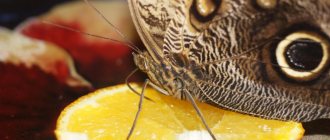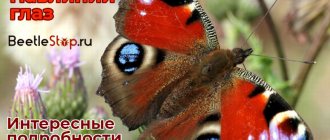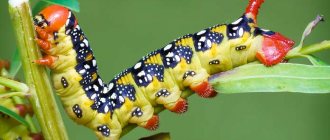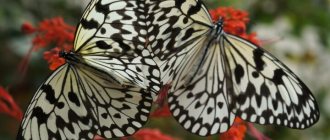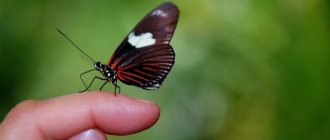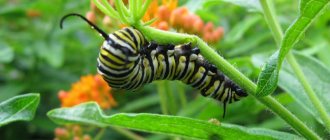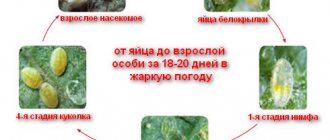Caterpillars
Apple codling moth
The main goal in the life of a caterpillar is food. They eat, as a rule, the green parts of plants, which are richest in nutrients. Others feed on fruits by sitting inside them, such as the well-known codling moth. And some have adapted to eat wood, wool and even wax.
Gypsy moth
Caterpillars eat a lot. Their body weight can increase 50,000 times. Since the caterpillar's body covers do not stretch well, the larvae molt several times during their lives, completely shedding their old skin. Some caterpillars can feed only on one specific type of plant, while others can feed on a wide variety of plant species, such as the gypsy moth or the American white butterfly, which are capable of eating the leaves of more than 300 species of trees and shrubs. Many caterpillars are able to secrete webs made of protein through their mouths. Some do this in huge quantities, weaving a cocoon from silk or coarser fibers - chesuchi. To obtain silk thread, people have been raising silkworm caterpillars since ancient times. The cocoon made by the caterpillar unwinds, resulting in a thin silk thread up to 1.5 km long.
Nowadays, butterflies are bred not only for silk. The population of many tropical countries lives by breeding the largest and brightly colored species for the manufacture of various crafts, paintings, panels of wings, and boxes of dried butterflies. The auction value of some rare specimens can reach several thousand dollars. But most of the butterflies sold continue to be caught in the wild, which, together with the constantly shrinking natural areas of their habitat, leads to a decrease in the number of these beautiful and often useful insects.
What to feed butterflies?
The basis of nutrition of these insects in nature is pollen and nectar of flowers. You can easily prepare it at home by mixing water, sugar and honey (10 parts water and 1 part sugar and honey).
But their diet is not limited to this. For example, they happily consume the juice of slightly rotten fruits: bananas, pears, oranges, melons, apples. Should be fed 2 times a day.
Some species of these insects require sodium to survive. Often butterflies land on the whitened trunks of fruit trees and sweating people - this is how they get the salt they need.
What might you need?
In order for everything to succeed and the emerging butterflies to feel comfortable, you may need:
- Special insectarium. This is equipment designed for breeding butterflies, which contains everything necessary for their reproduction and full life. It will maintain a certain constant temperature, as well as a level of humidity, so that the insects will feel as if they were in the wild. Typically, an insectarium is a container with transparent walls, inside of which there is a humidifier and something like a heater. The kit may also include some plants. The cost of this equipment reaches 10-15 thousand. But you can make it with your own hands. To do this, make a frame from a box and slats, cover it with gauze, and place a heater and an air humidifier nearby (you can replace it with a container of water or regular spraying from a spray bottle). You can pour soil into the tray.
- Humidifier, heater. They are necessary to create and maintain optimal conditions for insects.
- Branches, leaves, plants. Branches are necessary, firstly, to create an environment as close to natural as possible. Secondly, they are used for hanging dolls. Caterpillars can feed on leaves. And flowers (especially those that produce sweet pollen) are very loved by adult butterflies.
- A thermometer will be required to constantly monitor the temperature. Ideally, it should be between 24-26 degrees.
Butterfly development: four stages of the life cycle
So, butterflies are insects with complete transformation - they have all four stages of the corresponding life cycle: egg, pupa, caterpillar larva and imago - an adult insect. Let us consider sequentially the stages of transformation in butterflies.
Egg
First, the adult butterfly lays an egg and thereby gives rise to a new life. Depending on the type, eggs can be round, oval, cylindrical, conical, flattened and even bottle-shaped. Eggs differ not only in shape, but also in color (usually they are white with a green tint, but other colors are not so rare - brown, red, blue, etc.).
The eggs are covered with a dense hard shell - the chorion. The embryo located under the chorion is equipped with a supply of nutrients, very similar to the well-known egg yolk. It is by this that the two main life forms of lepidopteran eggs are distinguished. Eggs of the first group are poor in yolk. Those species of butterflies that lay such eggs develop inactive and weak caterpillars. Outwardly, they look like tadpoles - a huge head and a thin, thin body. Caterpillars of such species must begin to feed immediately after emerging from the egg, only after which they acquire fully plump proportions. That is why butterflies of these species lay eggs on a food plant - on leaves, stems or branches. Eggs placed on plants are typical for diurnal butterflies, hawk moths, and many cutworms (especially lancets).
Cabbage butterfly eggs
In other butterflies, eggs are rich in yolk and provide the development of strong and active caterpillars. Having left the egg shell, these caterpillars immediately begin to crawl away and are able to cover sometimes quite significant distances for them before finding suitable food. Therefore, butterflies that lay such eggs do not need to worry too much about their placement - they lay them wherever they need to. Thinworms, for example, scatter eggs on the ground in bulk right on the fly. In addition to slender moths, this method is typical for bagworms, glassworts, many moths, cocoon moths and bear moths.
There are also lepidoptera that try to bury their eggs in the ground (some cutworms).
The number of eggs in a clutch also depends on the species and sometimes reaches 1000 or more, however, not all survive to the adult stage - this depends on factors such as temperature and humidity. In addition, butterfly eggs have no enemies from the insect world.
The average duration of the egg stage is 8-15 days, but in some species the eggs overwinter and this stage lasts months.
Caterpillar
A caterpillar is the larva of a butterfly. It is usually worm-shaped and has a gnawing mouthpart. As soon as the caterpillar is born, it begins to feed intensively. Most larvae feed on leaves, flowers and fruits of plants. Some species feed on wax and horny substances. There are also larvae - predators; their diet includes sedentary aphids, scale insects, etc.
During the process of growth, the caterpillar molts several times - changing its outer shell. On average, there are 4-5 molts, but there are also species that molt up to 40 times. After the last moult, the caterpillar turns into a pupa. Caterpillars of butterflies living in colder climates often do not have time to complete their life cycle in one summer and enter a winter diapause.
Caterpillar of the Swallowtail butterfly
Doll
The pupae do not move or feed, they just lie (hang) and wait, using up the reserves accumulated by the caterpillar. Outwardly, it seems that nothing is happening, but this last stage of the amazing transformation can be called a “turbulent calm.” At this time, very important life processes of restructuring the body are boiling inside the pupa, new organs appear and form.
The pupa is completely defenseless; the only thing that allows it to survive is its relative invisibility from its enemies - birds and predatory insects.
Butterfly pupa “Peacock eye”
Typically, the development of a butterfly in the pupa lasts 2-3 weeks, but in some species the pupa is a stage that enters winter diapause.
Imago
An adult insect, the imago, emerges from the pupa. The shell of the pupa bursts, and the imago, clinging to the edge of the shell with its feet, while exerting a lot of effort, crawls out.
A newborn butterfly cannot fly yet - its wings are small, as if curled, and wet. The insect necessarily climbs to a vertical elevation, where it remains until it fully spreads its wings. In 2-3 hours, the wings lose their elasticity, harden and acquire their final color. Now you can take your first flight!
The lifespan of an adult varies from several hours to several months, but on average the lifespan of a butterfly is only 2-3 weeks.
What you will need
- Container (something like an aquarium or a large plastic plant container with a net on top)
- Flowering plants (those that the caterpillar will feed on)
- About 5 cm of soil (if the caterpillar will pupate underground)
- Layer of newspapers or paper towels
Article information
This page has been viewed 24,927 times.
Was this article helpful?
Butterflies are the most beautiful insects, the sight of which touches any person, and a butterfly flying in the first rays of the spring sun causes wild delight in children. Science knows several thousand species of butterflies, and they live in almost all warm corners of our planet. Recently, it has become fashionable to use fireworks from live butterflies at weddings or other celebrations. The beauties released into the sky or indoors surprise guests much more than pigeons that are already fed up with them. At the same time, the question comes to everyone: “How did tropical butterflies end up here?” It's simple. It is quite possible to grow inhabitants of distant tropics in a city apartment - this is a new line of business from the “Business Ideas 2014” section.
Growing tropical butterflies at home
The best option for raising butterflies is to buy their pupae. At the moment, many Russian websites offer services for the sale of butterfly pupae. Most often orders are accepted for amounts of $100 and above. For this amount you can purchase up to 20 dolls. They are delivered in special foam boxes lined with cotton wool. Some companies offer free delivery, for example, through train conductors, and some charge up to $30 for delivery by rail or up to $50 for delivery by passing flight. Everyone chooses what is convenient and beneficial according to circumstances and location.
Before ordering dolls, you need to build housing for them. The insectarium itself can be built with your own hands. It must be equipped with a heater and humidifier. The air temperature should be at least 25 degrees, and the humidity should be about 70%. The butterfly house must have plenty of space, so to keep 10 butterflies, the structure must be at least 1 meter high and at least half a meter wide. It is better to make the outer wall of the future house from glass or transparent, safe plastic. The remaining walls can be constructed from plywood or aluminum sheets. In the house it is necessary to make planks, similar to the principle of a perch in a chicken coop, only fix them under each other at a distance of at least 20 cm. The pupae will be hung on these perches. Place several branchy sticks in a corner of one of the dark walls; the newly hatched beauty will dry her wings on them.
When purchasing pupae, companies give only an 80% guarantee that you will get butterflies from the pupae. By creating ideal living conditions for butterflies, you can ensure that they begin to reproduce in a new home. Butterflies feed on some sweet fruits, honey, sugar syrup or fruit sweet nectars for baby food. But if the butterflies still deign to reproduce in their house, then you will have to have a rich supply of greenery to feed their voracious caterpillars and even grow some tropical plants in greenhouse conditions.
This is interesting: read our other articles - “Business plan for breeding aquarium fish”, “Achatina - a giant African snail” and “Fennec fox - breeding and sale”.
Butterflies as a business idea Live butterflies can be offered as fireworks at holidays for children and adults or as additions to a romantic bouquet for a couple in love, packing them in envelopes one or several pieces. The price range here is varied; you can easily start at $20 per piece. With good and proper care, butterflies live on average up to 3 weeks, but even after their death they bring good profits to their owners. A properly dried butterfly is sent in a frame under glass and sold starting from $10 per piece to all lovers of beauty. You can also master the technique of making panels from dried butterfly wings, which can be simply invaluable.
(0 votes, average: 0 out of 5)
000 2014-03-31
Demand for butterflies
This type of insect is most popular among agencies involved in organizing various kinds of events - weddings, anniversaries, children's parties. Among the consumers of this service there are also ordinary citizens who are ready to pay a lot of money for a living gift. After all, the price for one butterfly can reach up to two thousand rubles, but rarely does anyone order only one.
Tropical butterflies are gradually replacing the wedding doves released into the air to celebrate the occasion.
Description and structure of the butterfly
If we consider the structure of a butterfly, we can distinguish two main parts: the body and the wings. In turn, the body consists of:
- heads (rounded shape, large eyes, antennae, mouthparts, most often in the form of a proboscis, may be underdeveloped);
- chest (most often consists of 3 segments) with 3 pairs of legs located on it;
- The abdomen (in the shape of an elongated cylinder) consists of 10 segments, with spiracles located on the sides.
Structure
Butterflies have 2 pairs of wings, which are covered with flat scales, which is why the order received the name Lepidoptera. The appearance of butterflies of different species is strikingly different from each other. This is due to the existence of many sizes and colors. The scales on the wings can be of very different shapes and colors. And the size of the wings themselves, depending on the species, varies from 2 mm to 30 cm.
Where do they live in nature?
There is a huge variety of butterflies that inhabit almost the entire planet, with the possible exception of the icy expanses of Antarctica and the highlands covered with snow all year round. The most numerous group of butterflies inhabits regions with a tropical climate, but quite a large number are also found in temperate latitudes.
According to scientists, the largest number of butterflies is in Peru and India (Sikkim state). Some species are distributed almost throughout the world, while others have a very narrow habitat. Lepidoptera can live not only on the plains, but also in the mountains at an altitude of several thousand kilometers above sea level.
What do butterflies eat?
Even a child can answer the question of what a butterfly eats. This is nectar and pollen of flowering plants, but besides this, in the diet of beautiful creatures:
- plant juices;
- sweet fruits;
- honey;
- tear fluid and blood of some animals;
- sweat and excrement of large animals.
In many species, adults do not eat at all, maintaining their livelihoods using nutrients accumulated during the caterpillar stage.
Reproduction
Reproduction of butterflies is often accompanied by various, sometimes very complex, forms of courtship. This could be mating dances or flights. Some butterflies secrete special pheromones that attract a partner of the opposite sex. Moreover, depending on the species, both females and males can release pheromones.
During mating, the female receives from the male not only sperm, but also proteins and trace elements necessary for the formation of eggs. The mating process can last from 15–20 minutes to several hours.
The benefits and harms of butterflies
The benefit or harm that butterflies bring largely depends on what stage of development the insects are at. Thus, the vast majority of caterpillars are pests that destroy both agricultural and wild plants. But adult butterflies participate in the pollination of many plants.
For reference! Many scientists are of the opinion that the role of butterflies in the pollination process is greatly exaggerated. When they drink nectar, they prefer not to get their paws dirty with pollen, which means they don’t transfer it to other plants.
Larvae and adult butterflies are food for birds and insectivorous animals. Some varieties of caterpillars feed on insect pests. Speaking about the benefits of butterflies, one cannot fail to mention the silkworm, which is used in the production of natural silk.
Well, of course, one cannot downplay the aesthetic significance of butterflies in human life. They help to understand and enjoy the beauty of nature.
Investment and ROI
The amount of money to invest in business development will depend on its scale. If the entire work process is planned to be organized at home, then the purchase of equipment may require about 150-250 thousand rubles. The business will pay off on average in a year if butterflies are actively sold.
In the case of organizing a park for excursions, costs can amount to up to 2 million rubles: this will include renting premises, paying staff, and equipment.
vseproip.com
Why is this necessary?
Many people breed butterflies for sale; in the last few years, it has become popular to give boxes of these graceful and beautiful creatures. Of course, when such a box is opened, all the butterflies will fly away, but the recipient of such an original souvenir will experience a lot of pleasant emotions. 20-30 butterflies can cost about 1-1.5 thousand rubles.
Another goal is a hobby. If such insects simply touch you, and you want to surround yourself with them, then why not make your dream come true? Just enjoy the process and the results and don't think about profit.
Let beautiful butterflies delight you or those around you and give positive emotions!
Demand for butterflies
This type of insect is most popular among agencies involved in organizing various kinds of events - weddings, anniversaries, children's parties. Among the consumers of this service there are also ordinary citizens who are ready to pay a lot of money for a living gift. After all, the price for one butterfly can reach up to two thousand rubles, but rarely does anyone order only one.
Tropical butterflies are gradually replacing the wedding doves released into the air to celebrate the occasion.
Methods of dealing with caterpillars
The appearance of caterpillars on plants does not bode well. These voracious insects can cause serious harm to a crop and even cause its death. In this case, at the first signs of their vital activity, it is necessary to take urgent measures to save the plants.
The following insecticides can be used to control caterpillars:
- Bitoxibacillin;
- Iskra M;
- Inta-vir;
- Senpai;
- Monsoon;
- Lepidocide.
To prevent damage, you can use decoctions based on tobacco leaves, chamomile, onion peels, tomato tops, and yarrow. The smell of these plants can scare off flying individuals, and they will not be able to lay eggs.
How to breed and keep butterflies
In order to breed butterflies as a home business, an entrepreneur will need:
- Specially equipped insectarium with adjustable humidity and temperature levels
- Exotic plants that can serve as food for caterpillars and habitat for butterflies
- Rare butterfly pupae
The room in which the butterflies will be located must have a ceiling height of at least three meters. You can build an insectarium yourself using drawings available online, but a reliable climate control system will need to be purchased from trusted suppliers. The main expenses when running a business such as butterfly farming are the purchase of pupae. The cost of one pupa is from 3 US dollars; the more beautiful and viable the butterfly, the more expensive the pupa is.
However, there is no guarantee that all purchased pupae will produce healthy, normally developed butterflies of the species declared by the seller. Lots of dolls are purchased from countries of the African, South American, and Asian continents. The minimum quantity is from 100 dolls. With such purchases, approximately 1/3 of the dolls turn out to be of poor quality. The butterfly lives from one week to two, depending on the conditions of detention, so it is necessary to purchase new pupae at least once every 14 days, and this is quite a serious investment.
Equipment and costs
To start a butterfly breeding business, you will need a room with a height of at least 3 meters. Equipment:
- Special insectariums with regulation of humidity, temperature and light levels.
- Greenhouse (greenhouse) for growing food for caterpillars.
- Humidifiers.
If an entrepreneur, in addition to breeding, plans to hold exhibitions on the premises, selling tickets, special personnel are hired. An administrator, a security guard, and a greenhouse worker will be needed. The founder himself will also have to actively participate in the activities of the butterfly park.
Amazing creatures
Caterpillars and their butterflies are not always alike; the color does not at all match the color of the future moth. Some larvae have similar features - spots, streaks of identical color. Only specialists and obvious fans of these insects can determine from which caterpillars and which butterflies emerge.
Butterfly caterpillars, photos and names are presented below.
- One of the most beautiful butterflies in our area is the peacock eye. The larva of this beauty is black in color with spines all over its body. The change in appearance is dramatic.
- Other black caterpillars will become wren butterflies.
- Amazing creation of bromeia. The caterpillar looks like a stick, and the butterfly has a very interesting woody color
- Green caterpillar with multi-colored pimples - cecropia.
- The black swallowtail has a simply irresistible color in green and blue tones. But there are also yellow dots on the caterpillar’s body.
- Dalcerida. It is not clear from the outside whether the larva will produce an insect or an animal. The appearance of the moth is no less unusual.
- The blue morpho is another creature that captivates with its appearance.
- Swallowtail is a butterfly well known in our area.
- The butterfly used to produce natural silk is the silkworm. She leads a sedentary lifestyle and practically does not use her wings for their intended purpose, despite the fact that their span reaches 60 mm. The larva forms a cocoon of silk threads up to 1500 m long.
Peacock butterfly and its caterpillar
Bramea and its caterpillar on the left, cecropia and its larva on the right
Black swallowtail butterfly
Dalcerida and its caterpillar on the left, blue morpho and its larva on the right
Swallowtail and its caterpillar on the left, silkworm and its larva on the right
Do caterpillars that manage to survive to the pupation stage always turn into moths - yes. Transformation always happens. However, in nature there are other insects whose larvae are similar to caterpillars, but they are called worms. At the end of the development process, they are destined to turn into beetles, bees, flies, and wasps. Sawflies are very similar to the larvae of butterflies; they are called false caterpillars.
People never cease to admire some types of butterflies; they keep them in the house, creating favorable living conditions for them.
Sources
- https://apest.ru/nasekomye/babochki/kak-gusenitsa-prevrashchaetsya-v-babochku/
- https://dr-dez.ru/mol/vse-li-gusenicy-stanovyatsya-babochkami.html
- https://www.krasnouhie.ru/zhiznennyj-cikl-babochek-metamorfoz-razvitie-babochki.html
- https://gkd.ru/405923a-kak-poyavlyayutsya-babochki-stadii-razvitiya
- https://WikiParazit.ru/babochki-i-moshki/prevraschenie-iz-gusenitsy-v-babochku.html
- https://moypitomec.ru/poznavatelno/stadii-razvitija-babochek.html
Breeding butterflies at home
Do your neighbors have fish, a cat or a parrot? In any case, if a beautiful butterfly becomes your pet, not only your guests and neighbors will be surprised, but you yourself will be surprised. The process of breeding butterflies is simple and does not require serious financial expenditure. To see a magnificent butterfly emerge from a caterpillar at home, you need to arm yourself with only two tools: time and patience.
There are two ways to get pets like butterflies. The first is to do everything yourself, the second is to buy the individuals you like from a nursery or farm. By choosing a simpler path, you deny yourself the pleasure of contemplating all the life cycles of an insect, and this is a real miracle. It is solely for these reasons that we strongly recommend that you start raising butterflies yourself.
Where to begin?
As you know, butterflies are insects with a full cycle of transformation, which scientists call holometamorphosis. The process consists of several phases:
- the appearance of an egg;
- caterpillar hatching;
- pupation;
- appearance of a butterfly.
Breeding butterflies should begin by searching for “material” that you will grow. Here are some tips on this matter:
finding insect eggs is not an easy task, because the individual itself is relatively small in size, one can only imagine how small its eggs will be. For example, the eggs of the Kapustyanka butterfly reach only half a millimeter in length - it will be difficult to notice them. So how to grow a butterfly from eggs? To make the “hunt” successful, we advise you to follow the butterfly for some time. These insects can lay eggs in 1-2 seconds, so even a light touch to a leaf or blade of grass can mean that the fruit is already there; finding the caterpillar is much easier. The specimens that we usually see are already grown caterpillars, ready to turn into pupae in 4-5 days. Be extremely careful when searching - you can often stumble upon false caterpillars from which hymenoptera insects will hatch. You can distinguish a butterfly caterpillar by the number of front legs (three pairs); You can also find a ready-made pupa in nature. Many species of butterflies “hide” in the ground, in dry leaves and even between boards in agricultural buildings
When starting to raise butterflies this way, pay attention to the time of year. If it is late autumn, the pupae should be placed in the refrigerator for several days.
Where to house and what to feed the butterfly?
As we have already mentioned, breeding butterflies at home does not require large financial expenditures. To conveniently place eggs, caterpillars or pupae, you will need a three-liter jar (based on the number of “tenants”), some gauze or other light fabric, and paper napkins. Cover the house of the future butterfly with napkins - they will need to be sprayed with water, which the insects need. Instead of a lid, put gauze on the jar and secure it with an elastic band or thread. That's all - your nursery is ready.
As for nutrition, everything here is also extremely simple: pay attention to the leaves in which you found eggs or a caterpillar. This is the plant that insects should be fed with.
Despite their small size, the caterpillars require replenishing the feeder every day. You will also have to clean the jar of old leaves and droppings with enviable regularity, as well as irrigate the surface.
How to grow a butterfly for sale?
To get offspring, you will need to mate two adult butterflies of the same species. We will be happy to describe this process in our subsequent materials.
babochki.kiev.ua
Rebirth
The appearance of a butterfly from a caterpillar, as well as breeding butterflies at home in general, is quite a fascinating process. The caterpillar produces something like a sticky web, from which it creates a cocoon for itself. Cocoons can be of various types, for example transparent and soft or opaque, hard and elastic. The type of its cocoon directly depends on the type of butterfly; for example, moths tend to create their cocoon directly on the ground. On average, pupation lasts only 2 or 3 days. Next, you should consider which species you are growing, since the pupa of different species may hatch at different times.
For example, wintering pupae - they must be kept in the cold for at least a month, and possibly more. For pupae, you need to create a certain temperature regime, namely 26-28°, and humidity from 60 to 90%. This will ensure the normal development of the butterfly and also protect it from drying out.
Therefore, keeping the container moisturized is extremely important.
When a butterfly emerges, its first action is to hang upside down, a process that allows it to spread its wings and lasts for several hours. To ensure such conditions, you need to place gnarled branches or a strip of toilet paper in the container. If the butterfly does not have the opportunity to hang, its wings will not spread out, and therefore the insect will not be able to fly.
The best treat for domestic butterflies is honey or sugar diluted in water. Such pets are tame and are not afraid of human presence. The main condition is to behave carefully so as not to harm the insect.
Investment and ROI
The amount of money to invest in business development will depend on its scale. If the entire work process is planned to be organized at home, then the purchase of equipment may require about 150-250 thousand rubles. The business will pay off on average in a year if butterflies are actively sold.
In the case of organizing a park for excursions, costs can amount to up to 2 million rubles: this will include renting premises, paying staff, and equipment.
vseproip.com
Warnings
- Be careful with caterpillars, some of them can be poisonous. Poison is their defense mechanism, so you should not touch them with your hands. If the poison gets into the eyes, it can damage the mucous membrane.
- If you decide to purchase caterpillars, keep in mind that in many countries legal approval is required.
- Do not collect rare, endangered species of caterpillars and butterflies that are endangered and protected by law.
- Beware of the brightly spotted spiny caterpillars because they can be very poisonous. Once you have some experience in raising butterflies, you can try to carefully transfer such a caterpillar to your container, because they usually grow into large, beautiful butterflies.
- Try to collect caterpillars in your region, not outside the city. You should not buy caterpillars from a supplier who breeds butterflies. Keep in mind that butterflies that are not native to your area may harm native butterfly species and may even displace them. Therefore, some states have laws against the cultivation of foreign species of animals.
- Many species of butterflies feed exclusively on nettles, so be careful when collecting these caterpillars!
flying flower
It’s nice in the summer, hiding somewhere in a meadow, watching a cheerful round dance, seeing a carefree, fluttering cloud. Butterflies are flying flowers. I love them for their beauty, fragility, grace. There are many legends associated with butterflies. The ancient Greeks considered them to be the souls of the dead. According to legend, the titan Prometheus molded the first man from earth and water, and the goddess Athena put a butterfly soul in his head. The Greeks and Romans used the same word - anima, psyche - to call the soul and the butterfly. In Ancient England, butterflies were also considered the souls of the departed. They were called soul souls. In the old days, in Southern Russia, peasants, seeing a moth flying near a candle, commemorated the dead, believing that it was the soul of the deceased who had flown into the world to remind the living of itself.
Fossil butterflies have been known since the Jurassic period. Many specimens of ancient insects have been preserved in fossilized resinous amber. Most often, flies are found in Nilas amber, beetles are in second place, and butterflies are only in third place. The rare occurrence of butterflies in the resin is due to the fact that the wings of butterflies are covered with scales, which reliably protected insects from sticking.
Since early childhood I have been observing wildlife. This summer I was attracted to a very large black and yellow butterfly that often feasted on nectar in our front garden. My attempts to catch her ended in nothing.
Good luck awaited in the dill bed. There, right under the umbrella, three magnificent caterpillars were discovered. Green, belted with black belts, with red-orange dots, they were of different sizes (1.5 cm, 2.4 cm, 3.5 cm). The next day I found another one, 4.5 cm long. I was happy - now I had the opportunity to hatch a butterfly myself.
In order to implement my idea, I outlined several points or tasks:
* Determine the type of butterfly from the caterpillar.
* Get acquainted with the characteristic features of the order, family, species.
* Feed the caterpillars.
* Keep records, collect photographic materials.
* Present the results in the form of a presentation and memo.
This is how my research project was born, the topic of which is >.
How to care for a domestic butterfly?
Keeping butterflies at home begins with preparing a clean, transparent plastic or glass container. It should contain plants as food, soil and twigs on which the caterpillar can crawl and later pupate. Such a container must be covered with a fine mesh or gauze for good ventilation.
It is important to feed the leaves of the tree or bush on which the caterpillar was found.
Some species are able to feed on different plants. But the majority prefer one thing - it’s easier for them to die than to eat unfamiliar food.
Leaves must be changed daily. They can be washed and soaked in water - this will be an additional source of moisture for the caterpillar. To keep them fresh throughout the day, they can be placed in tubes of flower water. Larger containers in the form of vases or jars are not a good option. The caterpillar can easily fall into them and die.
The container with the caterpillar should be located in a constant temperature indoors. To maintain moisture, it can be sprayed with a spray bottle.
It is necessary to clean the caterpillar's home every day. For convenience, you can put paper towels at the bottom of the container. Caterpillars are very voracious, so they excrete a lot of excrement. Therefore, paper will make the cleaning task easier.
When the caterpillar reaches the maximum size for its species, the pupation stage will begin. During this period, the caterpillar may change color, eat less, and become lethargic. Over the course of two or three days, the pupation process occurs. A suitable temperature is considered to be 26-28⁰C with humidity up to 90%. It is necessary to periodically irrigate the container for optimal development conditions.
The pupa should be located in a part where there is enough space to spread its wings. It may be necessary to move the leaf or twig to a more favorable point in the container.
It happens that the pupa dies - in this case the cocoon is darker. If you gently bend it and the color does not change, then it is dead.
The adult individual - the imago - appears after a few days, or even weeks. After emerging from the cocoon, the butterfly does not eat for a couple of hours. She spends this time opening and drying her wings. It’s good when there are vertical branches or sticks next to the doll, on which the lepidopterous beauty can sit comfortably.
